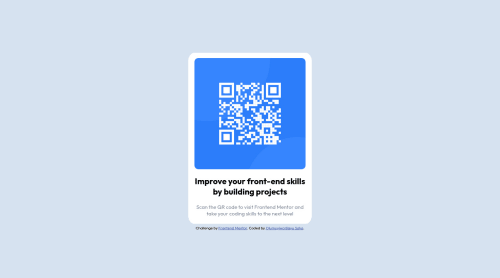QR Code Component using HTML and CSS only,

Solution retrospective
I'm new to working with the assets given as part of the design brief. I had to launch the png files and then try to get my measurements from there. I also ended up relying on em and vh figures for successfully configuring my design to be responsive.
I used percentages a lot to ensure the design was responsive. What is the best practice with respect to using percentages.
Please log in to post a comment
Log in with GitHubCommunity feedback
- @vanzasetia
Hi, Muyiwa! 👋
Congratulations on completing your first Frontend Mentor challenge! 🎉
I recommend using a code-formatter. This way, your code base will have a consistent format which makes it easier to read the code. I suggest using Prettier as your code-formatter.
Prettier · Opinionated Code Formatter
The alternative text of the QR code doesn't need to be uppercased. Also, it should describe the QR code. In this case, it will navigate the users after they scan it. So, the better alternative text can be "QR code to frontendmentor.io".
Don't use
idselectors for styling. There are two reasons for not using ID’s to style content:- They mess up specificity because they are too high (the most important reason).
- They are unique identifiers. So, they are not reusable on the same page.
Use single-class selectors whenever possible. This can help you produce a low-specificity stylesheet. As a result, it prevents you from having specificity issues.
Last suggestion, I recommend making the
bodyelement as a flex container to place the card in the middle of the page. Then, setmin-height: 100vhto make the card vertically centered. After that, remove the relative positioning andmargin: autofrom the#qrcomponent,I hope this helps. Happy coding!
Marked as helpful - @Tumelo4
It will be match easier if you used flex box or grid to center your container. for flex box body { display: flex; justify-content: center; align-item:center; } whatever element inside body will be on center of the body. Also try to separate styling and marks
Marked as helpful
Join our Discord community
Join thousands of Frontend Mentor community members taking the challenges, sharing resources, helping each other, and chatting about all things front-end!
Join our Discord